Key takeaways:
- Analytics is crucial for identifying growth opportunities and making informed decisions based on customer data.
- Defining and aligning Key Performance Indicators (KPIs) with business objectives is essential for measuring success and guiding strategic pivots.
- Implementing data-driven strategies fosters collaboration across departments, transforming data into a collective asset that drives innovation.
- Measuring the impact of changes requires a long-term perspective, focusing on patterns over time to understand true growth and improvement.

Understanding the Importance of Analytics
Analytics plays a crucial role in understanding not just where my growth opportunities lie, but also how to effectively leverage them. With every data point, I uncover stories about my customers that guide me toward making informed decisions. For instance, I once noticed a significant drop in engagement on a particular product line; digging into the analytics revealed customer preferences had shifted, prompting me to adapt my strategy.
I often find myself marveling at how numbers can reveal the heartbeat of my business. Isn’t it fascinating that insights derived from seemingly dry statistics can shape my marketing strategies? I’ve learned that ignoring these insights feels like driving blindfolded—each metric is a vital sign that points to whether I’m moving in the right direction or need to pivot my approach.
When I first started utilizing analytics, it was a game changer. I used to rely on gut feelings, but now I have concrete evidence to back my decisions. Isn’t it comforting to have data that shows whether my changes are resonating with my audience? By embracing analytics, I’ve not only gained clarity but also transformed the way I engage with my customers, driving consistent growth along the way.
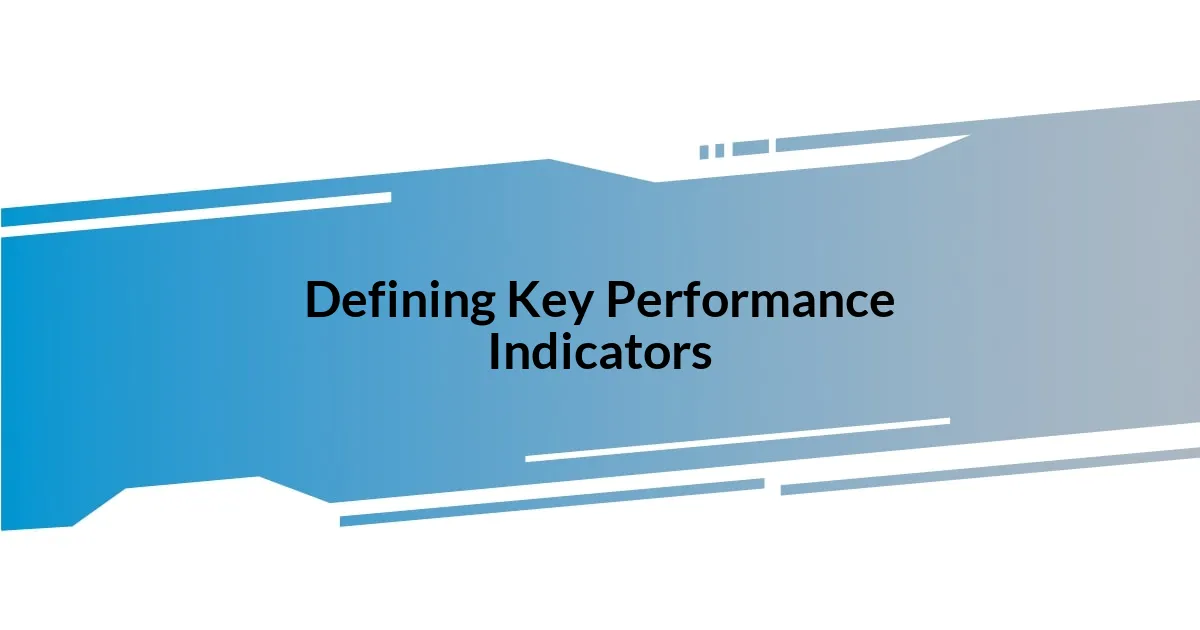
Defining Key Performance Indicators
Defining Key Performance Indicators (KPIs) is essential for anyone looking to use analytics effectively for growth. I vividly remember the first time I mapped out my KPIs; it was like uncovering a treasure map. Each indicator was a direction guiding me to insights that would enhance my decision-making. The clarity these KPIs gave me transformed abstract goals into tangible targets, helping me pinpoint what truly matters in my business.
When I analyze my performance, I find it enlightening to ensure every KPI aligns with my overarching objectives. For example, I don’t just track website traffic; I focus on conversion rates, which tell me how effectively I’m turning visitors into customers. This focus helped me tailor my marketing efforts and, more importantly, connect more genuinely with my audience. I often reflect on the journey of selecting and refining KPIs, as it was a learning experience that underscored the importance of alignment between metrics and my business values.
Ultimately, ensuring the right KPIs are in place has been pivotal for growth. They provide a way to measure success and recognize when I need to pivot my strategy. When I see forecasts and actuals line up, there’s a sense of accomplishment—and when they don’t, it’s not just a setback; it’s a learning opportunity. This approach fosters a growth mindset that keeps me striving for improvements, both personally and professionally.
| KPI | Description |
|---|---|
| Website Traffic | The number of visitors to your website, indicating overall interest. |
| Conversion Rate | The percentage of visitors who take a desired action, reflecting campaign effectiveness. |
| Customer Retention Rate | The percentage of customers who continue to do business with you over time, showing customer loyalty. |
| Return on Investment (ROI) | Measures the profitability of an investment relative to its cost, guiding budget decisions. |
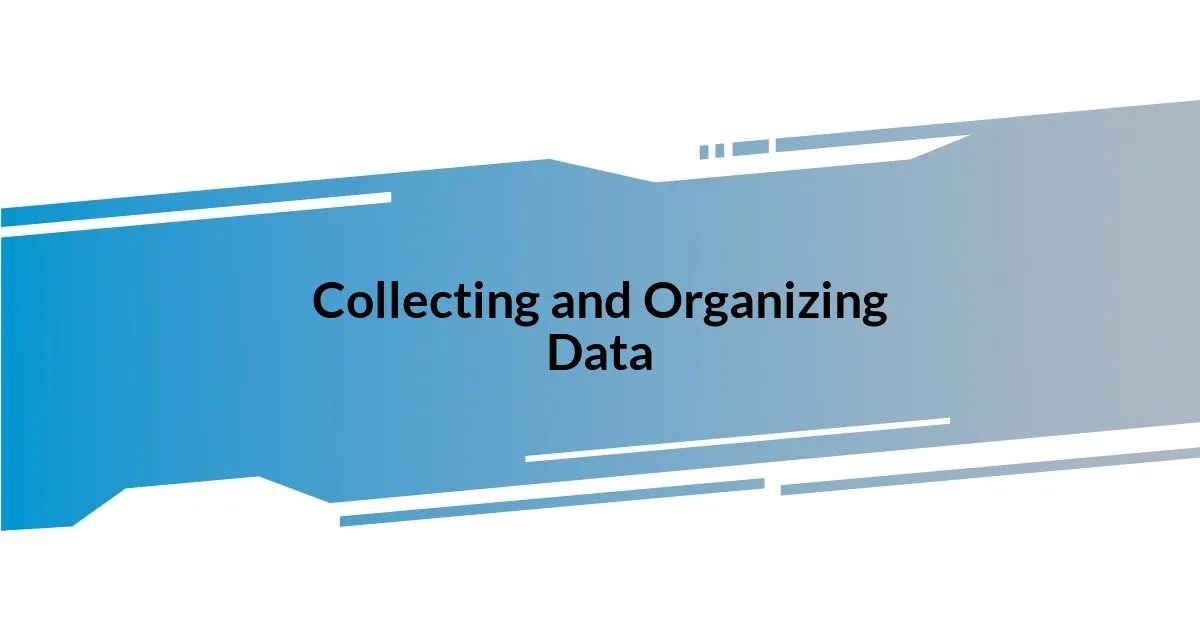
Collecting and Organizing Data
Collecting and organizing data is like setting the stage for a performance—everything needs to be in its right place. I remember when I first started gathering data; spreadsheets were my best friends! I’d spend hours sorting through data points, often feeling overwhelmed. However, I quickly learned that categorizing data based on relevance and usage made all the difference. For instance, I created specific sections within my spreadsheets for customer demographics, purchase histories, and engagement metrics, which allowed me to easily access critical insights when needed.
- Use descriptive labels: This will streamline the data retrieval process later.
- Regularly review and update your data: Keep it current to reflect real-time trends.
- Implement a central database: This reduces confusion and makes collaboration easier.
- Backup your data: Protect your valuable insights from unexpected disruptions.
- Utilize visualization tools: They help in quickly interpreting complex data sets.
It’s incredible how organized data can transform the analytics process. As I became more adept at collection, I felt more empowered. There’s something particularly satisfying about watching a well-organized report come together, knowing every piece contributes to a bigger picture. When I have clarity in my data, it’s like finding an old friend; it rekindles my enthusiasm for diving deeper into interpretation and strategy.
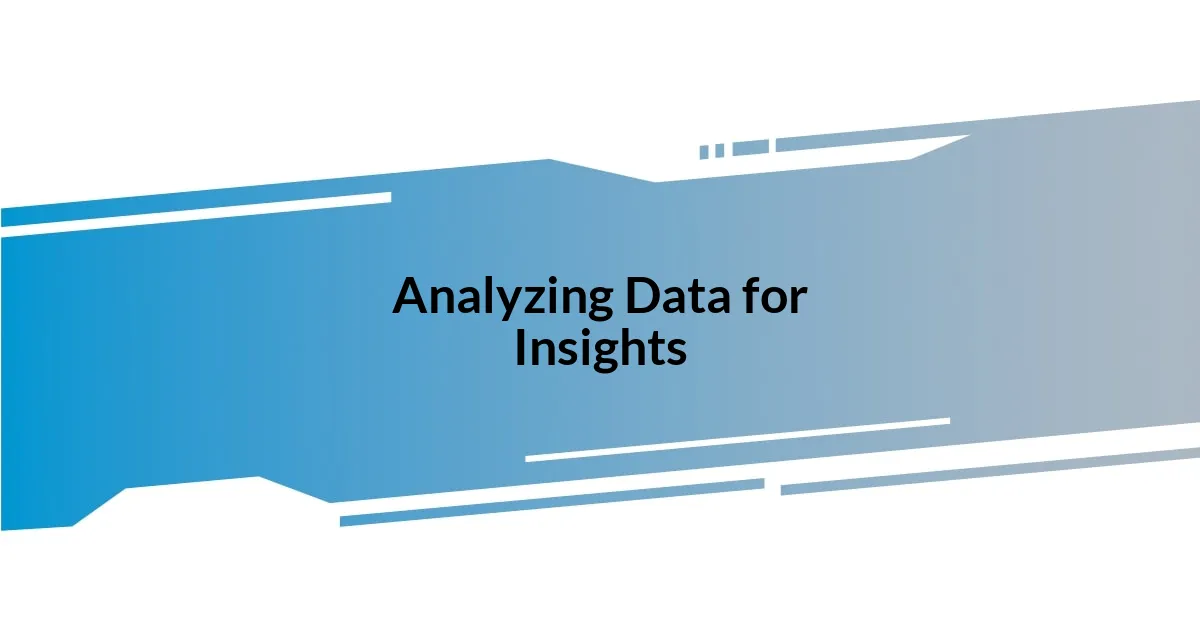
Analyzing Data for Insights
Analyzing data for insights is where the magic truly happens. There have been moments when I’ve scoured through piles of data, only to stumble upon a surprising trend that changed my perspective entirely. For instance, during one of my quarterly reviews, I noticed that our newest product line was performing exceptionally well among a demographic I hadn’t previously targeted. It was a lightbulb moment that pushed me to tailor my marketing strategies toward this group. Isn’t it fascinating how a single data point can lead to such significant shifts in direction?
I often reflect on how crucial it is to shift my mindset from viewing data as just numbers to seeing it as a storytelling medium. Each dataset has a narrative waiting to unfold, and I strive to listen. When I analyze customer feedback, for example, I don’t just look for trends; I look for emotions behind the responses. I recall a time when analyzing customer reviews revealed not just product likes and dislikes, but revealed deep insights into what my audience values emotionally. This understanding helped me design more resonant campaigns, ultimately strengthening our connection with customers.
Employing data visualization tools has been a game-changer for me. In my experience, transforming raw data into visually appealing charts made it easier—both for me and my team—to understand and discuss our findings. I remember when we used a simple pie chart to represent customer demographics during a brainstorming session; the room buzzed with ideas almost immediately! Seeing the data come alive ignited a collective energy—it’s moments like these that reinforce the importance of not just analyzing data, but presenting it in an engaging way. How can you leverage visuals to foster collaboration in your team? I’ve found that making the data digestible opens doors for innovative ideas and strategies to emerge.
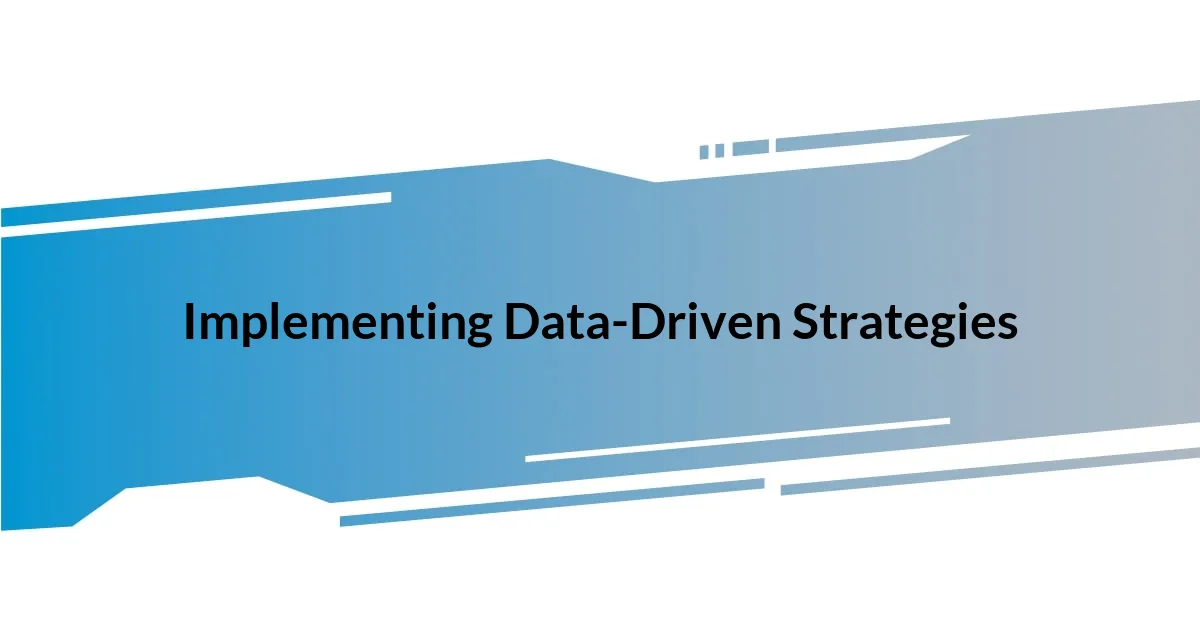
Implementing Data-Driven Strategies
Implementing data-driven strategies requires a proactive approach to decision-making. Early in my career, I learned that merely collecting data wasn’t enough; I needed to integrate it into our daily operations. For instance, after analyzing user engagement metrics, I suggested a shift in our social media strategy that prioritized video content. The immediate increase in engagement was exhilarating and confirmed that utilizing data to guide decisions can yield impressive results. Have you ever made a change based on data that surprised you?
Another key aspect of implementing these strategies is fostering a culture that embraces data across the organization. When I started involving team members from different departments in discussions centered around data insights, I noticed a shift in mindset. Suddenly, data wasn’t just my responsibility; it became a collective asset. I vividly recall a meeting where marketing and product development collaborated after examining user feedback together. The rich dialogue we had not only generated new ideas but also created a sense of ownership and excitement among my peers. Isn’t it amazing how data can act as a unifying force within a team?
Finally, it’s crucial to establish clear goals driven by the insights gained from data. One memorable instance was when we set out to improve our customer retention rates. By analyzing churn metrics, we identified pain points within the user journey. Armed with specific targets and actionable strategies, we implemented changes that resulted in a noticeable uptick in customer satisfaction. It was gratifying to see efforts translate into tangible outcomes. How do you ensure that your data analysis translates into meaningful actions? I’ve found that aligning data-driven goals with the team’s vision keeps everyone motivated and focused on growth.
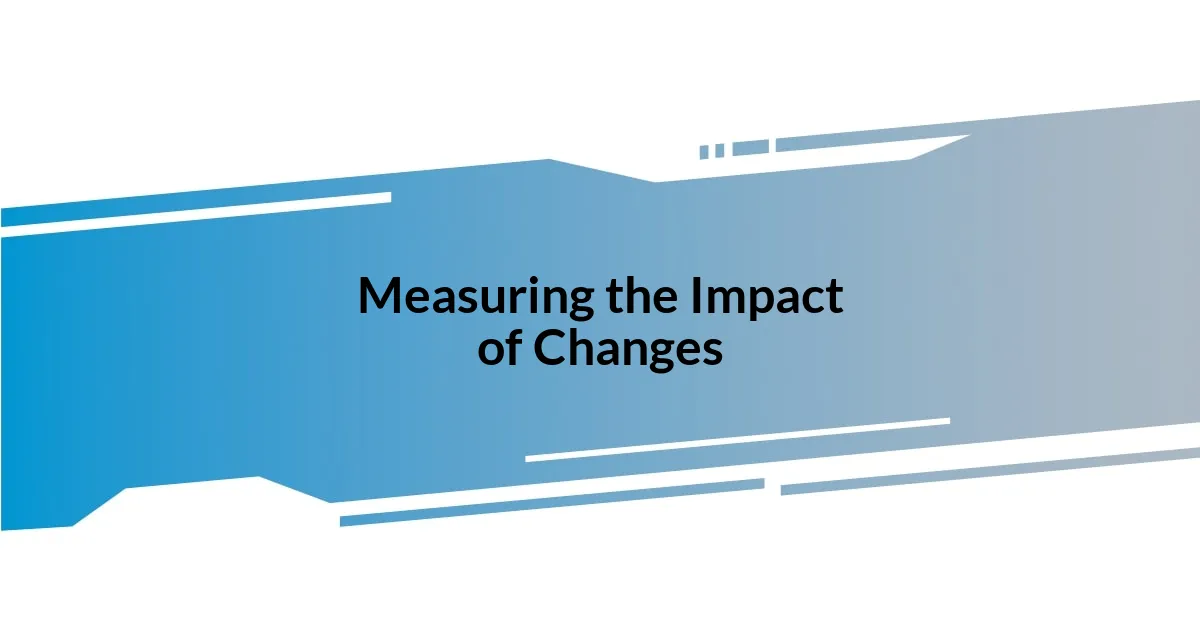
Measuring the Impact of Changes
Measuring the impact of changes can feel like piecing together a puzzle. I remember a project where we revamped our website’s layout based on user feedback. After rolling out the new design, I carefully tracked metrics like bounce rates and average session duration. The immediate drop in bounce rates was a refreshing sight, signifying that users were captivated by the changes. Isn’t it intriguing how even slight alterations can lead to drastic improvements?
As I reflect on my experiences, I realize the importance of patience in this process. It’s not enough to observe short-term metrics; I’ve learned to look for patterns over time. For instance, after launching a new customer loyalty program, it took a few months to see the true benefits. Digging into repeat purchase rates revealed that customer loyalty had indeed increased. This insight reminded me that measuring changes requires a long-term perspective; growth isn’t always instantaneous, is it?
Engagement with stakeholders is another layer that adds depth to measuring impact. Once, in a leadership meeting, I shared data visualizations of how recent adjustments had influenced our sales. The reactions were priceless—excited nods, a few gasps, and even some brainstorming over how to capitalize on this momentum. It was heartening to witness the team rally around these insights. How often do we overlook the power of sharing success stories? I’ve found that celebrating these victories together strengthens our commitment to ongoing analysis and growth.
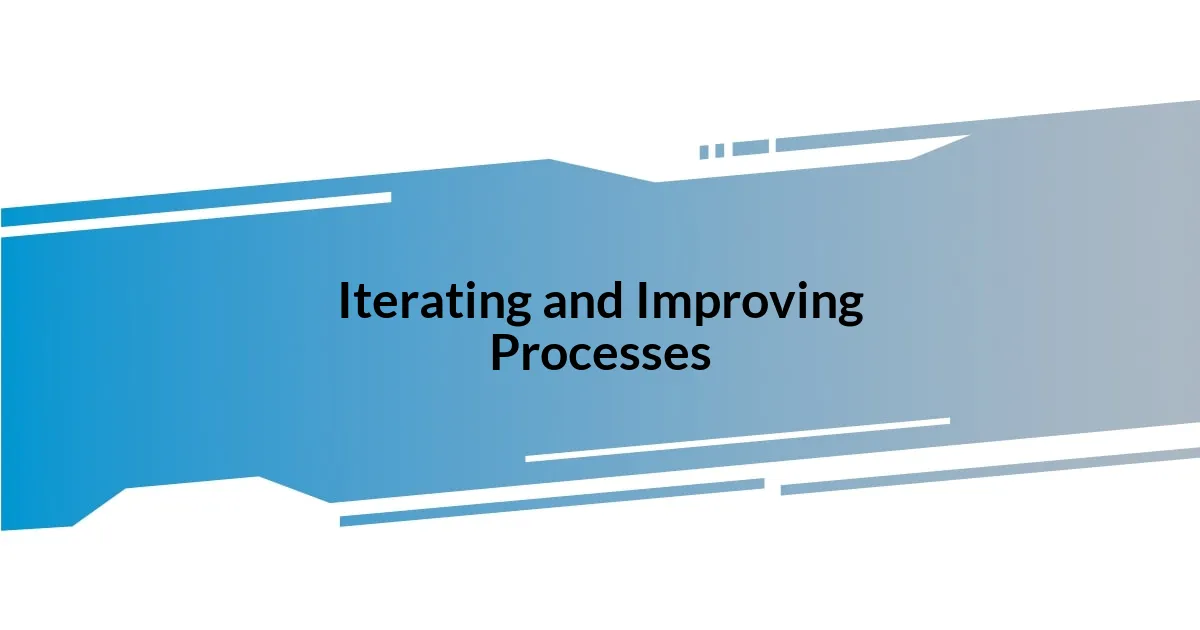
Iterating and Improving Processes
Every time I think about iterating and improving processes, I’m reminded of a particular project where we took a deep dive into customer feedback. After implementing some suggested tweaks to our onboarding process, I tracked how these changes impacted newcomer engagement. There was a palpable shift—users who once struggled to navigate our platform were now finding their way with ease. Isn’t it fascinating how understanding user experiences can transform our approach?
What struck me most was the enthusiasm across the team during our follow-up meetings. As we reviewed data, I saw genuine excitement—a lightbulb moment for many of my colleagues. They recognized that each iteration was not just a line on a report; it was a direct reflection of real users benefiting from our efforts. I often ask myself: how can we cultivate this spirit of collaboration to drive continuous improvement? I believe it’s in sharing successes and failures alike, making everyone feel invested in the outcome.
In my experience, refining processes isn’t just about metrics; it’s about telling a story. I once facilitated a workshop focused on identifying bottlenecks in our workflow. By weaving together data and personal accounts of team challenges, we collectively transformed our frustrations into actionable steps. Seeing the team leave with a new understanding of their roles within the process—empowered and ready to tackle problems—was immensely rewarding. Can you recall a moment when teamwork genuinely sparked innovation? For me, those moments are what fuel my passion for iterative development.